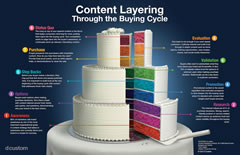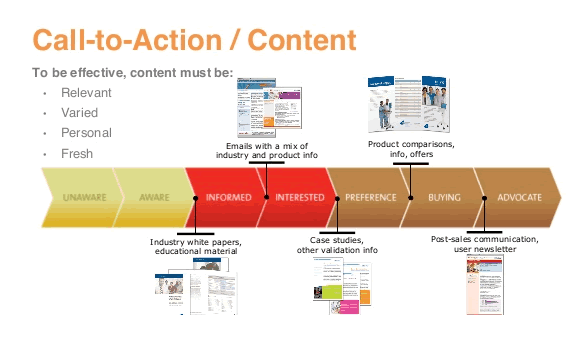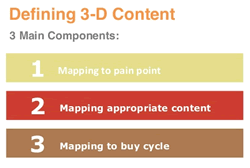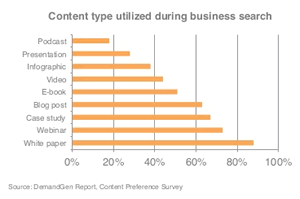Content marketing fits in a broader integrated marketing strategy and it requires a strategy of its own: a guide to shape your content marketing strategy.
Content marketing is much more than creating, distributing and sharing content in order to engage audiences, generate leads, improve branding, and other marketing goals you can serve with content marketing.

It needs a strategic approach and that’s what a content marketing strategy is all about. Content marketing fits in a broader integrated marketing approach and needs some strategic consideration. However, just as is the case with other marketing techniques (email marketing or social media marketing, for instance) the content marketing strategy needs to be integrated in a broader strategy.
A content marketing strategy (not to be confused with a content strategy) analyzes the different ways content marketing can be used across the buyer’s journey, the customer life cycle and/or the different customer experience touchpoints but it goes beyond that. Essentially a content marketing strategy looks how content marketing (not content) can be used in a strategic way as such and for and with other marketing, customer and sales strategies.
Questions to address in a content marketing strategy

- Who are the buyer personas and what are their content needs and preferences? This questions looks at the type of information different ‘archetypes’ of buyers seek during their buying journey and maps the customer touchpoints, preferred communication channels, and – to some extent – the content formats, although that’s a question for the content strategy too. Buyer personas haven’t been invented for content marketing. They are used for an overall marketing strategy. But in a content marketing strategy you take a more complete look at them.
- Which marketing and other organizational goals can we realize or improve by better using content marketing? An example: traffic building, conversion optimization, event marketing, lead generation and management, email marketing, social media marketing, marketing automation, customer service, etc. can all be improved by a better usage of content and content marketing. Your content marketing strategy looks at this. As a matter of fact, don’t just ask what organizational goals content marketing serves as in the chart. Many people, especially those calling the buying shots, have no clue what content marketing is and so do many executives, even in marketing. So, ask what organizational goals you can support and strengthen instead of trying to separate content marketing from the overall equation.
- Which content marketing metrics and KPIs do we need to gauge success, in correlation with other marketing metrics and KPIs? Although there are some typical metrics used in content marketing it’s important to speak a common language across all marketing and even business efforts. Content marketing is not an island. One of the crucial success factors in implementing marketing ROI across the organization and content marketing ROI as well is finding common metrics and using a common language between different departments.
- How will we structure the internal organization – or better: how will we make sure that all content marketing related processes and flows are properly organized, in correlation with other marketing processes and/or teams? Often, content marketing thinkers advice to build teams that are more or less dedicated to content marketing. In practice, this seldom happens (except in some major firms) and teams better focus on the tasks and goals than the exact roles, realizing each company is different.
- For which other marketing goals and even business purposes – on top of the usual suspects – can we use content marketing? Examples: to support your customer service team, to empower sales, to optimize website conversions, etc.
- Which organizational processes, stumbling blocks, competitor data, management goals, customer insights, business stakeholders, teams, external partners, overall marketing priorities, etc. do I need to know in order to succeed? Before even thinking about content strategy, content inventorization or content production, these crucial questions need to be known.
- How is the industry you are in changing? And more specifically: how is the buyer’s journey of your buyer personas evolving in the industries your customers are active in and your business is active in. What role can content marketing play? As an example: look at the evolutions in the B2B services industry. Content plays a clear role but look further. For instance: Key Account Management is a priority in that industry. Can it be served using an optimized content marketing strategy? Also look at the influencer sphere of the buyers in that industry and at the different types of buyers.
- What questions do we need to answer and steps do we need to plan to put our content marketing strategy in action and move to the content strategy that looks at more content-related aspects?
- What existing budgets can we tap into to better achieve the goals using content in areas where return is below expectations (and what are these areas, of course)? An example: you may have an overall budget for your website but maybe it’s better to invest in more relevant content for your buyer personas instead and putting that design makeover on hold this year. Or maybe your organization invests a bit too much in generating traffic and leads but conversions stay behind. You can turn down the volume a bit and invest more in conversion optimization and lead nurturing, using content.
- How do we forecast and get budgets when no existing budgets can be tapped into or adapted? If your organization is missing out on important opportunities – and it always is – you need to make the calculated case for additional budgets.
These are some questions to answer in the content marketing strategy.
Why do you need a content marketing strategy?
The main reason you need a content marketing strategy is because content marketing is not an island.
Content marketing is an umbrella term. This means that it can be used for numerous reasons and can mean many things to many people. It’s not as universally defined as search engine optimization, for instance. This is exactly the reason why you need to think about the strategic role of content marketing within your organization and its ecosystem.
Without a content marketing strategy, you risk focusing on the content – and content strategy – too much and not seeing the overall goals anymore. In fact, this is one of the most crucial and deadly mistakes in content marketing. Unfortunately, this disconnected view on content marketing happens very often and leads to a focus on the wrong things.
In an age where everything gets integrated and taking into account the fact that content marketing – and social media marketing – is a huge umbrella terms this mistake of content-centricity can not be made.
Finally, by looking at the role of content marketing in a strategic way, that’s integrated with overall marketing and customer goals, you don’t need to get buy-in for content marketing or even make the case. You’re most of all being a smarter and more effective marketer. In social media marketing, executives needed to approve budgets that were sitting somewhere else. In content marketing that’s less the case as it’s connected with many other marketing goals and is not something “additional”. This doesn’t mean that a solid content marketing plan does not often require additional budgets but you’ll sell more business and a better brand perception to the C-suite, not necessarily a content marketing strategy.
In the ‘modern’ approach of content marketing, where more people look at the role of content in branding, reach, engagement, social and SEO. especially in a pure branding, reach and engagement approach, organizations look less at buyer personas but rather at audiences. Nevertheless, such a view requires a content marketing strategy as well. Unless your company lives from website traffic, a pure publishing model without an overall strategy makes no sense. It’s also advisable to not look at content marketing from the pure social and search context.
The steps in a strategic content marketing approach
While a content marketing strategy first looks at the strategic place of content marketing in the overall marketing process, there is also a planning and organizational dimension, mapping the different steps regarding content planning, mapping, creation, etc. In this sense, a content strategy involves various components. In most cases several of them come back but here are some common questions to answer or tasks to fulfill in a content strategy.
Let’s detail the content marketing strategy a bit more with a quick list of things to do.
- Analyzing what content is needed to fulfill different business goals across the customer journey or for branding purposes (often overlapping, each touchpoint has a branding dimension as well).
- Making an inventory of existing content and other resources or pieces of information that can be turned into content.
- Setting up the proper content planning, collaboration and scheduling processes.
- Developing a narrative that takes into account the brand’s promise and unique value proposition. Link the brand with the business goal and customer intent through content. Establish the tone of voice, style (guide), etc.
- Automating specific marketing processes, often triggered, using the right content at the right time on the right place.
- Planning a content strategy for different channels. OK, channels are never the priority but, on the other hand, each channel has specific characteristics, technical aspects, usage patterns, etc. Twitter is not Google is not email is not LinkedIn is not a webinar or a trade show.
- Making sure the content gets found by and shared with the different buyer personas and target audiences.
- Defining content-specific metrics and KPIs you will need to see if the overall marketing/business goals as defined in the content marketing strategy and ideally for your marketing ROI
- Creating, sourcing, aggregating, curating, optimizing content: or just getting it done using the tactics that work best.
- Defining a proper mix that fits the goals and the customer journey, regarding formats, channels, etc.
- Providing the content in different formats, each with their specific calls-to-action, depending on individual stages. Offer a variety of content types and formats. Not for the sake of it but because different segments and personas have different needs. Furthermore, if you can avoid message fatigue, several touchpoints are good, certainly also from a brand perspective. There is nothing wrong with repetition, variety, choice and multiple formats. As long as it’s relevant.
- Mapping content to pain points, questions and buying cycle. Elaborating on the buyer personas from a content strategy perspective. Look at the buyer journey but also the sales cycle (and, as opposed to popular belief, both are not aligned or the same).
- Planning campaigns in the overall marketing strategy whereby various content marketing tactics can be combined.
- Defining governance, content flows, managing content assets, storing ideas and data, etc.
- Training the people that will be involved in the planning, execution and follow-up.
- Closing the loop between your mrketing and sales, which involves content as well.
- Looking at less typical content needs, e.g. for customer service.
- Analyzing: competitors, markets, what customers/prospects want and say, the marketing place, a baseline analysis, etc.
- Testing, optimizing, testing, optimizing, testing, optimizing,…
- Etc.
More resources on content marketing strategy
Below we take a look at the so-called 3D content mapping approach but of course there are many other aspects and approaches regarding content marketing strategy. Here are a few you might want to check out.
- Frameworks for smart content marketing programs
- Developing a content strategy for customer engagement
- Content marketing strategy: content formats in the changing buyer journey
- Content marketing strategy beyond the first degree(s): value chains
- Getting internal buy-in for a content marketing strategy – part 1
- Content marketing: organization and management
- Content marketing success in 7 steps
- The role of influencers in a content marketing strategy
3D content mapping: a strategic approach
A few years ago, Arketi Group launched something called “3D Content Mapping”. It’s not really a model to define a content strategy but rather a summary of three parameters to take into account for customer-centric content mapping (and planning). Consider it as some extra food for thought.
Three dimensions to consider in a B2B content strategy
Segmentation
You know what segmentation is. In general, it means that your content should appeal to prospects/customers in function of their profile, behavior, journey, personas, etc. You probably think “I am doing that” but instead of targeting people in function of demographics or job functions take it further: industry, expressed needs and challenges, past behavior, triggers, digital signals, cross-channel customer data, whatever. But, most importantly: look at the pain points, questions and concerns of your prospects.
The buying cycle/sales cycle
Let me quote the people of Arketi Group: “Today’s prospects are much more in control of the information flow, relying on trusted online resources and solution providers’ websites far more often than sales reps to identify solutions, evaluate options and develop short lists for further consideration. The role of today’s BtoB marketers in this new environment is to offer the right content, matched to the individual prospect’s level of interest”. That’s using customized content for lead nurturing, in function of your customer’s offline and digital footprints and where he is in the buying cycle.
Content type
As Arketi Group says “keep the message fresh”. But also make sure you use several content options, regarding format, channel and trigger (push, pull). Every prospect has his own preferences and in a cross-channel lead nurturing approach, meeting those should be the most obvious thing on earth. The type of content really depends on different elements in the above mentioned other two dimensions: pain points, behavior, personas, stages in the sales cycle, you name it. Arketi further developed the model over the last few years and I think it’s a nice way to look at it, certainly in B2B.
Content marketing is about offering the content to your prospects in function of their needs, desires, reading preferences etc. And, certainly in B2B, about the customer life cycle. In the end, that is customer-centricity and thus, by definition, cross-channel and multi-channel (or let’s just say channel-agnostic).




